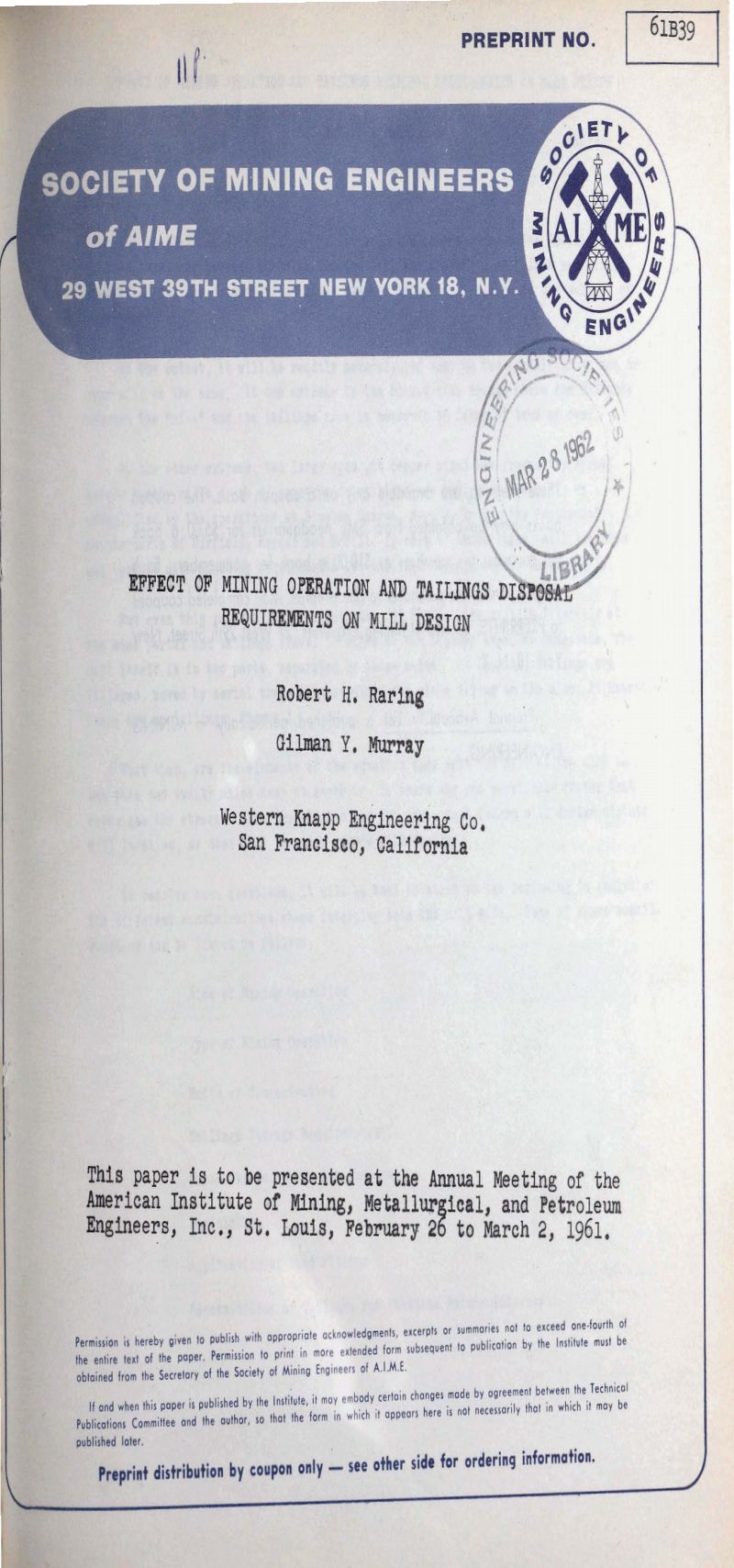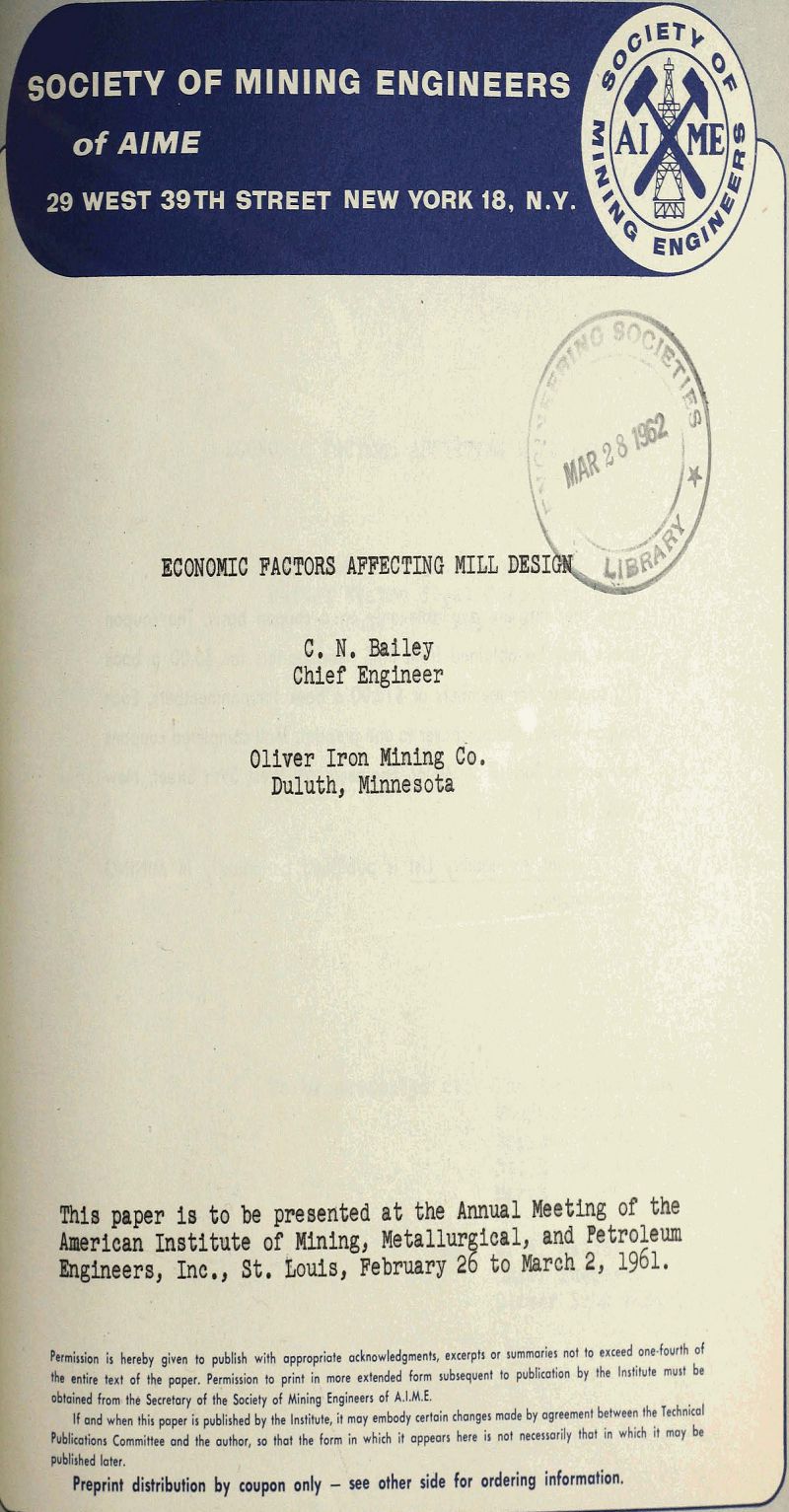Talking about engineering economics in mill design reminds me of an old saying “There are several ways to handle women but nobody knows what they are.” I’m sure that the same economic factors do not apply to each of our mill designs, but for the sake of emphasis, it is well to review a few of them. They are so simple that we are apt to feel they are not important. Other speakers today are talking about the engineering factors of mill design, but I’m asking the question “Have we checked the economic factors involved in these designs? Have we checked the obvious? Many great discoveries have resulted from analysis of the things that appeared to be obvious all the time.
What are some of these economic factors? Perhaps the most basic one is simply the value of minerals in place. If minerals have value in the ground, they have value only because many important and different considerations add up to the probability that the minerals can be mined, beneficiated and disposed of profitably. The size, formation and quality of the ore body, the distance from market, and the transportation available to the market area, depreciation rates, taxes, and the ownership interests involved are but some of the factors that must dovetail into the answer of profit, an answer prerequisite to hoped-for financing.
Competition is one economic factor that cannot be overlooked when designing a mill. The right way to become competitive is through the lasting benefits of cost reduction by proper mill design. Most of us have seen mines that were shut down, not because they were worked out, but because they could not remain competitive. Their processing costs were too high. Maybe some of you have seen the old copper diggings at Jerome, Colorado. For many years on the Iron Range of Minnesota, the washing plants recovered only 70 to 80 per cent of the iron in the crude feed to the mill.
Did your drawings call for 300 lb. floor load throughout the mill? Could you have specified 300 lb. floor loads at certain locations and reduced the remaining floor loads to 100 lbs.? Did you specify larger bays than were necessary Did you call for supporting vibrating loads on the building steel, or did you support them individually to reduce the cost of the building? A 10 per cent reduction in investment may be a possibility in your next mill and still not jeopardize your designs. It may be just the margin you need to remain competitive in the years of low production.
To summarize this whole idea, let me say that as engineers we cannot shrug off the responsibility that is ours. Facilities must be designed so they result in the lowest possible cost to our companies – not necessarily the lowest capital investment, but the lowest cost when depreciation, operation and maintenance are taken into consideration. We have to be far-sighted because sometimes competition catches up to us rapidly. Look how the airplanes have affected railroad passenger business.
Using the iron ore industry of Minnesota again as an example, the taconite deposits located there have only recently been classified as ore. Before they were considered of small value, but today, as mentioned before, there are three plants extracting iron as magnetite from taconite rock. The potential worth of this ore in terms of usable concentrates has had a profound effect on mill design.
The life of a plant and its depreciation rate also have an effect on mill design. During the war years, plants were built that had a designed life of five to six years. The plants were mostly of wood or galvanized iron, if available. Piping frequently took the shortest route – which is a diagonal – rather than around square corners, ladders were used frequently in place of stairs, dirt floors instead of concrete, etc.
Effect of Mining Operation and Tailings Disposal Requirements
Viewed abstractly, a mill may be defined as a mineral processing facility located somewhere between the mine and the tailings storage area. Just how mining operations and the demands.of tailings storage affect mill design is the subject of this paper.
At the outset, it will be readily acknowledged that no two installations can or ever will be the same. At one extreme is the bucket line dredge where the distance between the “mine” and the tailings area is measured in terms of tens of feet.
At the other extreme, the large open pit copper mines are frequently spread across twenty miles or so of countryside with the ore moving to the mill, as exemplified by the operations at Bingham Canyon, Ray, or Ruth the “upstream” counterparts of Garfield, Hayden and McGill. In each of these cases, mill location was largely determined by requirements for tailings storage and/or water supply.
What then, are the elements of the equation that puts the mill at the mine in , one case and twenty miles away at another? Is there any one particular factor that- outweighs the others? Like the chicken and the egg – does modern mill design dictate mill location, or does mill location govern mill design?
Ratio of Concentration – High ratios of concentration favor close-in location of the mill since nothing is gained by moving waste – other than for tailings storage considerations. The operations at Braden and Reserve point up the influence exerted by the ratio of concentration.
At Braden, the distance between mine and tailings dam is 37 miles; at Reserve it is 47 miles. At Braden the mill is literally at the mine; at Reserve the mill is at the tailings disposal site where an abundant water supply (Lake Superior) is also available.
Tailing Storage Requirements – The days when tailings could be “cut loose” from a plant and allowed to find their way down a convenient stream have long since passed. The growth in size of plants and enactment of legislation on stream pollution have effectively put an end to the old practice of letting plant waste material seek its, own storage basin.
Ideally, a tailing site should have the following characteristics:
- It should be down stream.from the plant so that tailings disposal is by gravity.
- It should have minimum storage capacity of double the proved and probable ore reserves.
- It should have natural environment that will minimize the danger of dam failure and consequent property damage.
- It should make water reclaim and reuse possible.
- It should minimize the dust nuisance with respect to commercial and residential establishments.
- It should allow for possible future reworking of the tailings..
Where milling operations have been established for some time and large tailings dams have been built up, dust can get to be a distinct nuisance and can influence mill site selection. In final decisions on tailing site, the wind rose pattern must be considered since prevailing winds can carry fine dry tailings to populated centers.
This factor in itself is an adequate basis for giving thought and attention to proper tailings storage. Techniques involving the use of hydrocyclones to make a sand-slime split of the tailings with the sand going for building up the berm have been described in the literature, and have reached a high level of development. By this method the slime pond is contained and relatively £&ear water drawn off by means of barge-mounted pumps and otherwise. The recirculation of reclaimed water reduces the requirements for makeup water and In many cases permits operating levels that spell the difference between profit and lose.


